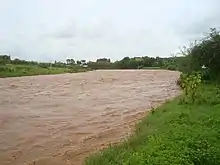Gilgel Abay
Gilgel Abay (Amharic: ግልገል አባይ, Gǝlgäl Abbay), or Lesser Abay, is a river of central Ethiopia. Rising in the mountains of Gojjam, it flows northward to empty into south-western Lake Tana at 11°48′N 37°7′E. Tributaries of the Gilgel Abbay include the Ashar, Jamma, Kelti and the Koger. It was regarded as the true source of the Nile for a long time and the Jesuit priest Pedro Paez visited it in 1618. The name Gilgel Abbay means Lesser Nile, as Abbay is the name for the Blue Nile.

Characteristics
It is a meandering river, with a catchment area of 3887 km³. Near its mouth it is 71 meter wide, with a slope gradient of 0.7 metre per kilometre. The average diameter of the bed material is 0.37 mm (sand).[1]
Sediment transport
The river transports carries annually 22,185 tonnes of bedload and 7.6 million tonnes of suspended sediment to Lake Tana.[1]
See also
References
- Hanibal Lemma, and colleagues (2019). "Bedload transport measurements in the Gilgel Abay River, Lake Tana Basin, Ethiopia". Journal of Hydrology. 577: 123968. doi:10.1016/j.jhydrol.2019.123968.
Further reading
- S. Uhlenbrook, Y. Mohamed, and A. S. Gragne, "Analyzing catchment behavior through catchment modeling in the Gilgel Abay, Upper Blue Nile River Basin, Ethiopia." Hydrol. Earth Syst. Sci., 14, 2153–2165, 2010
- Hydrologic Impact of Land-Use Change in The Upper Gilgel Abay River Basin, Ethiopia; TOPMODEL http://www.itc.nl/library/papers_2010/msc/wrem/gumindoga.pdf